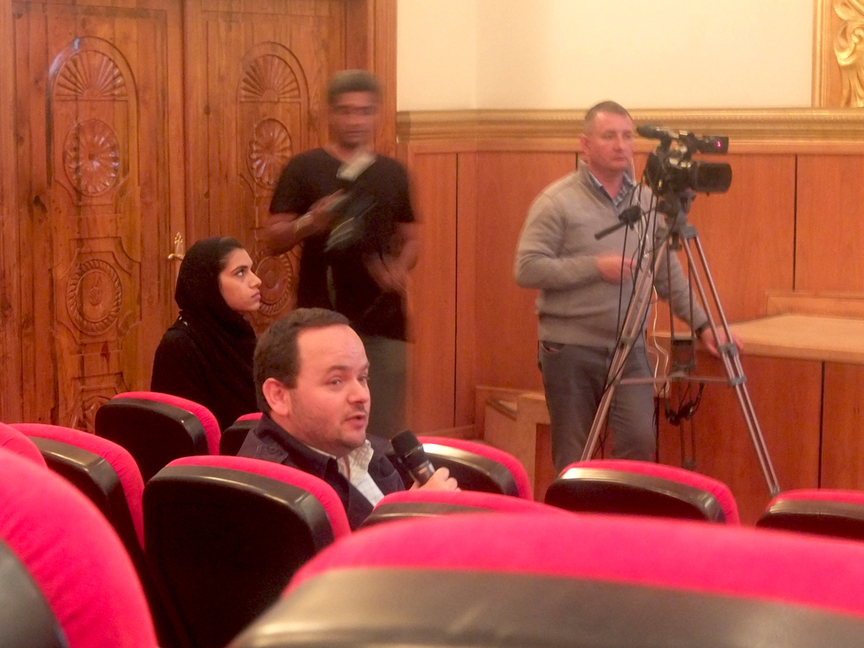
R
E
V N
E
X
T
Film still from Edmondo Desnoes’ Memories of Underdevelopment (1968). All photos by Kevin Jones for ArtAsiaPacific.
March Meeting 2015: (Day 4) Memories Of Our Underdevelopment, A Symposium—Discussions Curated By Ayreen Anastas and Rene Gabri
The final day of the March Meeting 2015 talks were marred by absence. Ayreen Anastas, one of the artist-duo curating the day’s discussions, had become ill the night before. Her partner in curatorial crime, Rene Gabri, was able to muster a few hours for the talks before he was called to her hospital bedside. The pair had united a panel of diverse thinkers and artists to fuel the day, yet two of these participants were themselves absent: Ashok Sukumaran of artist collective CAMP, a Gulf Labor member, who was denied a United Arab Emirates visa; and artist Walid Raad, who had been expected by the artist-organizers despite being unannounced on the official program. During his brief time at the symposium’s helm, Gabri evoked the previous night’s screening of his and Anastas’ film, memories of our underdevelopment (2015), foregrounding how the cinematic piece spotlights “places not on the map”—most notably unrecognized bedouin villages in Israel’s Naqab. As the speakers—who remained largely un-introduced to the wider audience and their fields of expertise made evident only when they took the floor—succumbed to the leader-less, freeform exchange of ideas that ensued, it seemed like we, too, were suddenly somewhere “off the map,” set adrift in a suspended discursive space. Here in Sharjah—under the auspices of a local art foundation with a long history of bringing people together—voices from the Occupy movement, the Gezi resistance from Turkey and Gulf Labor mingled with those of worldwide thinkers to take hard stabs at big, societal issues. Struggle after struggle—rights-less South Asian workers in the UAE, global discrimination between the “backward” and modern peoples, the complicity of contemporary art in neo-liberal processes—the discussions advanced in fits and starts to conclude with the promise of . . . further discussions.
This year the March Meeting felt very much like a project within the coinciding Sharjah Biennial. Over the past three days, curator Eungie Joo’s title for the Biennial, The past, the present, the possible, has been prodded, examined, refashioned and riffed off—such as with Day 1’s attempts to “salvage” past exhibitions and elusive collaborations, and the interrogating of how to transcend the current notion of “state” on Days 2 and 3. Yet nothing seemed so fully at the core of Joo’s conceit than the symposium of Day 4. Prior to the Biennial, much was made of Joo’s conversation with artist Danh Vo that had led to her articulation of the title, itself a reference to Henri Lefebvre’s 1968 novel Right to the City. The thought conveyed here is two-sided: Can contemporary art still matter enough to hoist us beyond our current political confinement? What are the alternative ways of thinking that will take us there?
Day 4, perhaps more than any other, seemed to approach the brink of this “alternative thinking.” Drawing inspiration from what he called “indigenous philosophies,” sociologist Rolando Vázquez Melken introduced the idea of “relationality”—a framework for thinking of relations to the self and the other, which take into account the ancestral dimension of nature. The activist potency of art, evoked by lawyer-artist Amin Husain of Gulf Labor, was cast less as a means of bringing down the state and more as a way of transforming the groups of artists practicing it. Artist Shaina Anand, CAMP member and Gulf Labor activist, who spoke stirringly of her visits to workers in far-flung UAE labor camps—the reality countering the Potemkin villages brandished by the Guggenheim (“We don’t need nicer prisons,” Anand said)—is confident in the power of the community.
This spirit of community, shared vocabulary and collective transformation was central to much of the symposium’s underlying thinking, evident in ideas such as collective liberation (“If workers’ demands are not met, somehow my own freedom doesn’t exist”) and institutional boycott as a builder of social relations between boycotters. In an odd way, if any conclusion was to be drawn from today’s meanderings, it was precisely the premise that kicked off all this thinking in the first place—March Meeting 2014, held under the rallying cry of “Come Together.” So, in the waning moments of March Meeting 2015, have we magically come full circle back to where we started? And what of those absent? Surely coming together should transcend administrative entanglements and state bullying. “Their denial of entry may be a good sign,” offered Egyptian artist Hassan Khan. “That reaction means there is some power.”
Dinner was peppered by splinter discussions, which took place before the March Meeting 2015 assembly headed off to contemplate another performance by percussion artist Uriel Barthélémi that evening. On the beach between Sharjah and the neighboring emirate of Ajman, car headlights flooded the night session as Barthélémi mesmerized the crowd yet again with his second performance from the “Souls’ Landscape” series, entitled Earth Layers.






